Choosing Varieties
Choosing the right lavender variety is a key first step in your lavender-growing journey. There are over 45 species and hundreds of varieties of lavender, each suited to different climates, purposes, and aesthetics. For beginners, focusing on hardy, adaptable types like English Lavender (Lavandula angustifolia) or French Lavender (Lavandula dentata) is recommended.
- English Lavender: Known for its sweet fragrance and compact growth habit, this variety thrives in temperate climates. Popular cultivars like 'Munstead' and 'Hidcote' are perfect for fragrant garden plants and drying for sachets or culinary use.
- French Lavender: This type features unique, showy flower bracts and is better suited for warmer climates. It’s a good choice for decorative purposes in garden beds and containers.
- Lavandin (Lavandula x intermedia): A hybrid of English and Portuguese lavender, lavandin produces large flower spikes and a strong scent, making it ideal for essential oils.
When selecting lavender varieties, consider your climate, soil type, and how you plan to use the plant. Check with local agricultural extension groups or organic gardening suppliers for advice on the best varieties for your area.
Sunlight Needs
Lavender thrives in full sun and requires at least 6–8 hours of direct sunlight daily. Insufficient sunlight can result in leggy growth, reduced blooms, and lower fragrance levels. If you're growing lavender in a region with intense afternoon heat, partial shade during the hottest part of the day may benefit the plants.
For indoor lavender cultivation, place the pots near a south-facing window to ensure adequate light. Using grow lights can supplement natural light if necessary, but be sure to avoid overwatering in lower-light conditions. The keyword for success is consistent light exposure—this is essential for robust growth and fragrant blooms.
Watering Tips
One of the most common mistakes made by new gardeners is overwatering lavender. Lavender is a drought-tolerant plant that prefers dry, well-draining soil. Overly wet conditions can lead to root rot and other problems. Here's what you need to know about lavender watering:
- Frequency: Water young plants weekly until established, but reduce frequency as they mature. Mature lavender plants often thrive with deep watering every 2–3 weeks during dry spells.
- Technique: Water at the base of the plant to keep foliage dry and minimize the risk of fungal diseases.
- Soil Drainage: Ensure your soil is well-drained, with a sandy or loamy texture. If necessary, amend clay soils with organic matter or sand to improve drainage.
Using sustainable watering practices, such as drip irrigation, can help conserve water while keeping your lavender healthy. Remember, lavender prefers a "less is more" approach to watering, making it a standout among low-maintenance plants.
Common Pests and Diseases
While lavender is generally pest-resistant, a few issues can occasionally arise. Knowing how to identify and manage these problems is crucial for maintaining a healthy garden.
Pests
- Aphids: These small, sap-sucking insects can weaken plants and attract ants. Organic control methods include spraying with neem oil or using a strong stream of water to dislodge them.
- Spittlebugs: Recognizable by their frothy white deposits on stems, spittlebugs are usually harmless but can be rinsed off with water if they become a nuisance.
- Whiteflies: Found mainly in warm climates, these pests can be deterred with yellow sticky traps or natural predators like ladybugs.
Diseases
- Root Rot: Overwatering and poor soil drainage are the primary causes of root rot. Prevent this by ensuring proper watering and amending heavy soils.
- Fungal Infections: High humidity or crowded plants can lead to powdery mildew or leaf spots. Prune plants to increase air circulation and avoid overhead watering.
- Alfalfa Mosaic Virus: This virus, transmitted by aphids, causes yellowing and stunted growth. Remove and dispose of infected plants promptly.
Using organic pest control methods, such as introducing beneficial insects or applying horticultural oils, ensures a sustainable approach to dealing with lavender pests and diseases. Healthy plants grown under optimal conditions are less likely to face significant problems.
Lavender Care Basics
Caring for lavender is easy when you understand its needs. A key factor in lavender care basics is soil preparation. Lavender thrives in alkaline to neutral soils with a pH of 6.5 to 8. Conduct a soil test before planting to ensure the right conditions. If your soil is too acidic, adding lime can help raise the pH.
In addition to soil preparation, regular pruning is essential for maintaining your lavender's health and appearance. Prune back about one-third of the plant after flowering to encourage bushy growth and prevent woody stems. Avoid cutting into old wood, as lavender may not regenerate from these sections.
Mulching around lavender plants with organic materials like bark or straw can help retain moisture and suppress weeds. However, keep mulch away from the base of the plant to prevent fungal issues.
In Summary
Lavender is one of the best fragrant garden plants for new gardeners, thanks to its beauty, versatility, and low-maintenance nature. By choosing suitable varieties, providing plenty of sunlight, following proper watering techniques, and staying vigilant about common pests and diseases, you can enjoy thriving lavender plants in your garden. Organic and sustainable practices will not only enhance your garden’s health but also support beneficial insects and a vibrant ecosystem.
Whether you're creating a lavender hedge, filling your garden with its calming scent, or simply enjoying its blooms, growing lavender is a rewarding experience for gardeners of all skill levels. For even more tailored advice, consult local agricultural extension offices or garden centers familiar with lavender varieties that suit your region.
For more information, see our recipe on Lavender and Lemon Basil Biscuits, and when the seasons change, don’t miss our guide on Overwintering Lavender for frost protection, wind barriers, and indoor care strategies.





